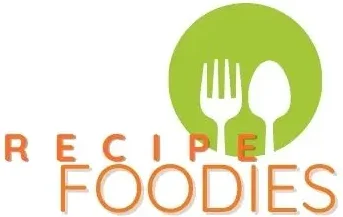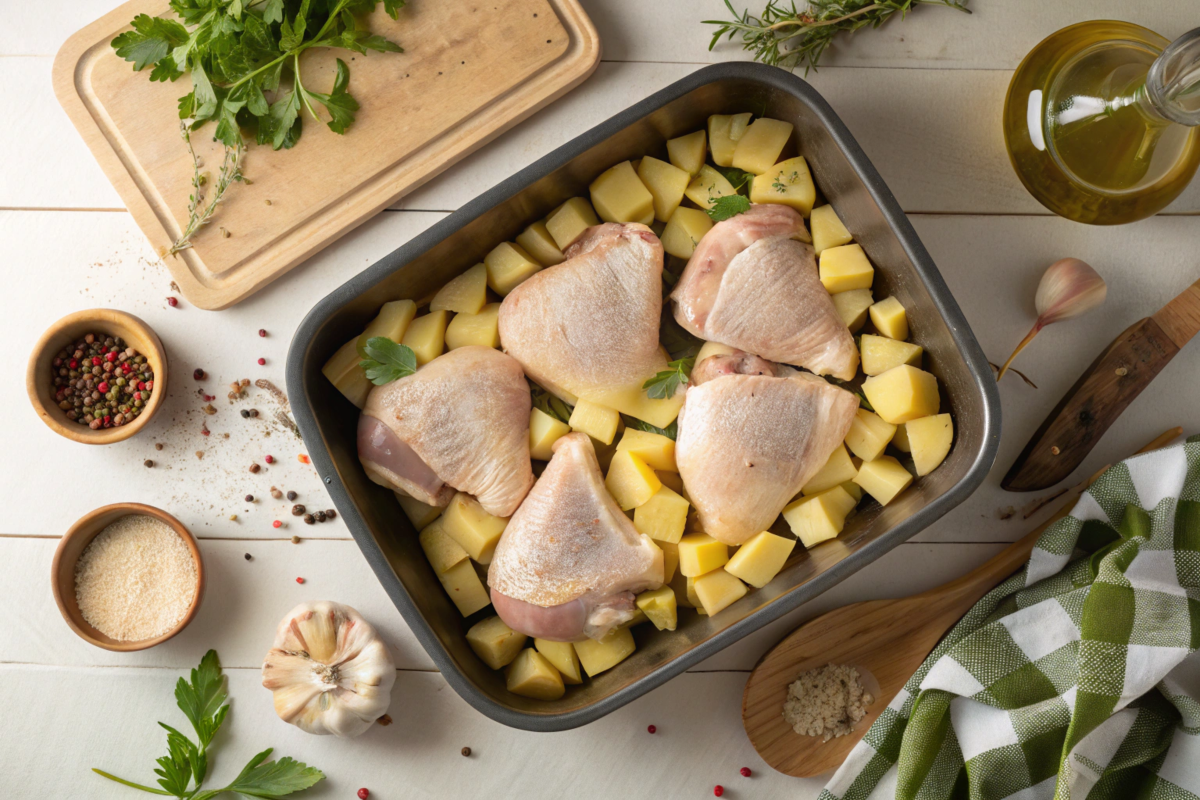Cooking raw chicken and potatoes together raises valid concerns about food safety, cross-contamination, and proper cooking techniques. However, when done correctly, this method can be both safe and convenient. Throughout this article, we’ll explore whether it’s OK to combine these two ingredients in a single dish, discuss best practices, and address common questions. You’ll learn how to prevent bacterial contamination, ensure food safety, and create delicious meals. By following these tips, you can confidently cook raw chicken and potatoes together without compromising safety or taste.
Is It OK to Cook Raw Chicken and Potatoes Together?
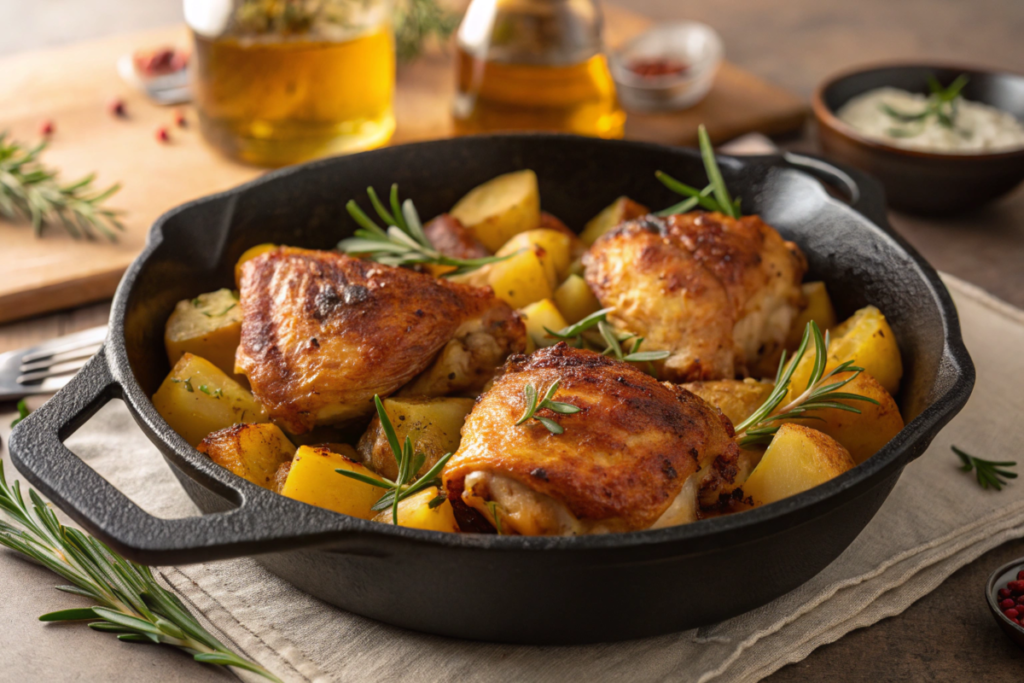
cooking raw chicken and potatoes together may sound like a timesaver, but is it truly safe? The short answer is yes—it can be done safely when you follow the proper precautions. The main concerns stem from the risk of cross-contamination and the need to ensure that both chicken and potatoes are cooked thoroughly to eliminate harmful bacteria.
Understanding the Key Risks
When dealing with raw chicken, bacteria such as Salmonella and Campylobacter are top of mind. These pathogens can cause serious illnesses if not handled correctly. Potatoes, though not inherently dangerous, can harbor surface dirt or contaminants that need to be washed away before cooking. Cooking them together means you’ll need to carefully manage the process to prevent these risks.
What Makes Cooking Them Together Practical?
One significant advantage of combining these ingredients is the ease of creating a one-pan dish. Roasting chicken and potatoes together allows the flavors to meld beautifully while saving time and reducing the number of dishes to wash. It’s a win-win if you follow safety measures, such as monitoring internal temperatures and maintaining proper hygiene during preparation.
To ensure safety, always cook chicken to an internal temperature of 165°F (74°C). Potatoes, on the other hand, should be tender when pierced with a fork, indicating they’re cooked through. Using a reliable meat thermometer can help you confirm this.
Linking this to external expertise, the Safe Minimum Internal Temperature Chart from FoodSafety.gov provides an excellent reference for ensuring your chicken reaches the right temperature.
Understanding Food Safety
Cooking raw chicken and potatoes together can be safe and convenient, but only when food safety is prioritized. Raw chicken poses a well-known risk due to harmful bacteria, while potatoes, though low-risk, require proper preparation to avoid contamination. This section covers the main concerns, including bacterial risks and the importance of avoiding cross-contamination.
Food Safety Concerns with Cooking Raw Chicken and Potatoes Together
One major concern when cooking raw chicken and potatoes together is the possibility of cross-contamination. This happens when bacteria from the chicken spread to other foods, utensils, or surfaces. If not addressed, cross-contamination can lead to foodborne illnesses.
Furthermore, cooking these ingredients together requires that both reach safe internal temperatures to kill harmful bacteria. Chicken, in particular, must reach 165°F (74°C) to ensure pathogens like Salmonella and Campylobacter are eliminated. Potatoes should also be cooked thoroughly, as undercooked potatoes can be unappetizing and potentially unsafe if they come into contact with raw chicken juices.
A clean and organized kitchen is essential when preparing these dishes. Washing your hands, utensils, and cutting boards after handling raw chicken will significantly reduce the risk of contamination. Proper food safety practices make all the difference when creating flavorful and safe meals.
Bacterial Risks Associated with Raw Chicken
Raw chicken is notorious for harboring bacteria like Salmonella and Campylobacter. These bacteria can survive on surfaces, utensils, and even hands, spreading to other foods like potatoes if precautions aren’t taken. Illnesses caused by these pathogens often result in symptoms such as diarrhea, fever, and abdominal cramps.
When combining chicken with potatoes in a single dish, it’s critical to ensure that all parts of the chicken are cooked to the correct temperature. Uneven cooking can leave parts of the chicken undercooked, increasing the risk of foodborne illness. A meat thermometer is your best ally in ensuring safety.
By contrast, cooking chicken thoroughly not only eliminates bacteria but also enhances its taste and texture. Ensuring proper hygiene from preparation to plating helps reduce the risks and allows you to enjoy your meal without worry.
Potential Contamination from Raw Potatoes
Though potatoes are relatively low-risk compared to chicken, they aren’t entirely immune to contamination. Potatoes can carry dirt, pesticides, or harmful bacteria on their surface, which is why washing them thoroughly before cooking is a must.
When potatoes are prepared alongside raw chicken, any exposure to uncooked chicken juices can lead to contamination. Cooking them together in the same pan is safe as long as both reach the appropriate temperature and no raw juices remain. Using a clean cutting board and properly washing all surfaces that come into contact with raw potatoes and chicken is essential.
Incorporating these steps ensures that your chicken and potatoes dish is both delicious and safe.
Cooking Methods and Safety Measures
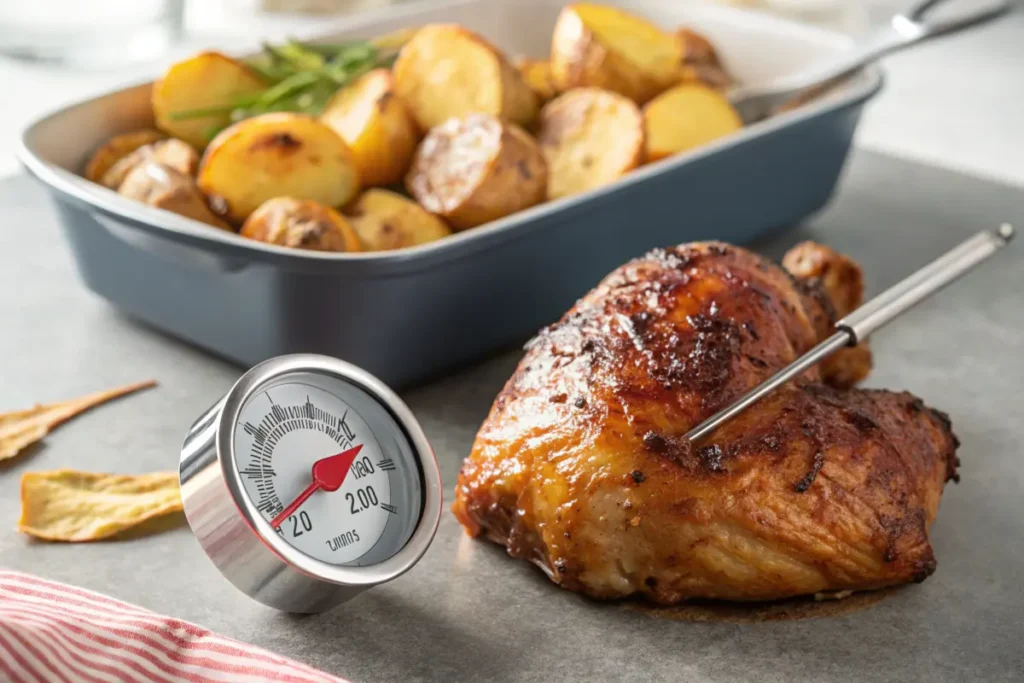
Cooking raw chicken and potatoes together requires not only attention to safety but also careful selection of the right cooking method. Whether roasting, boiling, or using a slow cooker, proper techniques will enhance the flavor and ensure your meal is safe to eat.
Safe Cooking Methods for Combining Raw Chicken and Potatoes
To safely cook raw chicken and potatoes together, you need to choose a method that ensures even cooking. Roasting, boiling, and slow cooking are popular options because they allow the chicken to cook thoroughly while infusing the potatoes with flavor. Whichever method you choose, the goal remains the same: to cook chicken to a minimum of 165°F (74°C) and potatoes until they’re tender.
When preparing these ingredients together, consider arranging them in a way that promotes even heat distribution. For example, placing chicken on top of the potatoes while roasting allows the juices to flavor the potatoes, creating a cohesive dish.
Roasting Chicken and Potatoes Together
Roasting is perhaps the most popular way to cook chicken and potatoes together. Preheat your oven to 400°F (200°C) and season both ingredients with your preferred herbs and spices. Arrange the chicken on top of the potatoes to ensure the flavors meld.
Cook the dish for about 40–50 minutes, checking periodically to ensure the chicken’s internal temperature reaches 165°F. The potatoes should be golden brown and fork-tender. This method not only ensures food safety but also results in a hearty, flavorful meal.
Boiling Chicken and Potatoes in the Same Pot
Boiling is another effective method, especially for soups or stews. Start by placing the chicken in a pot with enough water or broth to cover it. Bring the liquid to a boil and then reduce the heat to a simmer.
After the chicken has cooked for about 20 minutes, add the potatoes. Simmer until both the chicken is fully cooked, and the potatoes are tender. This method is perfect for creating comfort dishes like chicken soup or hearty stews while ensuring everything is cooked safely.
Using Slow Cookers for Chicken and Potato Dishes
Slow cookers are a convenient option for preparing chicken and potatoes with minimal effort. Begin by layering the potatoes on the bottom of the slow cooker and placing the chicken on top. Add seasoning, herbs, and a splash of liquid (like broth or water) to enhance the flavors.
Cook on low for 6–8 hours or high for 3–4 hours. Use a meat thermometer to verify that the chicken has reached 165°F. The slow cooker method is ideal for creating tender, flavorful dishes without constant monitoring.
Preventing Cross-Contamination
When handling one-pan chicken and potatoes, preventing cross-contamination is one of the most critical steps for ensuring food safety. Cross-contamination occurs when bacteria from raw chicken transfer to other foods, surfaces, or utensils, which can lead to foodborne illnesses. Following these practical tips will help you minimize risks and maintain a clean kitchen environment.
Tips to Prevent Cross-Contamination When Cooking Chicken and Potatoes
To prevent cross-contamination, start by keeping raw chicken separate from other ingredients, including potatoes, during preparation. Use designated cutting boards and knives for raw chicken and avoid reusing these tools for other foods without thorough cleaning. Washing your hands with soap and warm water before and after handling chicken is non-negotiable.
Additionally, store raw chicken on the lowest shelf of your refrigerator to prevent its juices from dripping onto other foods. When marinating chicken, use a sealed container and discard any leftover marinade that has come into contact with raw meat. These precautions ensure that bacteria remain confined and do not spread to your potatoes or other items in the kitchen.
Finally, always clean your countertops, cutting boards, and utensils immediately after handling raw chicken. Using a disinfectant or hot, soapy water will eliminate lingering bacteria and help maintain a safe cooking environment.
Proper Handling of Raw Chicken
Handling raw chicken properly is essential to reduce the risks of Salmonella and Campylobacter contamination. Start by purchasing fresh chicken with intact packaging to avoid leaks. Once at home, refrigerate the chicken promptly and cook it within one to two days. If you need to freeze it, store it in a leak-proof bag or container to avoid juices contaminating other items.
When preparing chicken, avoid rinsing it under the sink. This common practice can cause bacteria to spread via water splashes, contaminating your countertops and sink. Instead, pat the chicken dry with paper towels and discard them immediately.
Ensuring your chicken is properly handled from store to stove minimizes the chances of cross-contamination and makes your kitchen safer for preparing meals.
Safe Preparation of Potatoes
Although potatoes are less risky than chicken, they can still carry contaminants like dirt or bacteria on their skin. To prepare potatoes safely, start by washing them under running water with a vegetable brush to remove dirt and debris. If you’re peeling them, ensure the peeler is clean and sanitized before use.
Keep potatoes separate from raw chicken until they’re ready to be cooked together. Use a clean cutting board and knife exclusively for potatoes. If potatoes come into contact with raw chicken or its juices, rinse and cook them thoroughly to ensure safety. By preparing your potatoes carefully, you can enjoy their flavor without worrying about contamination.
Ensuring Proper Cooking Temperatures
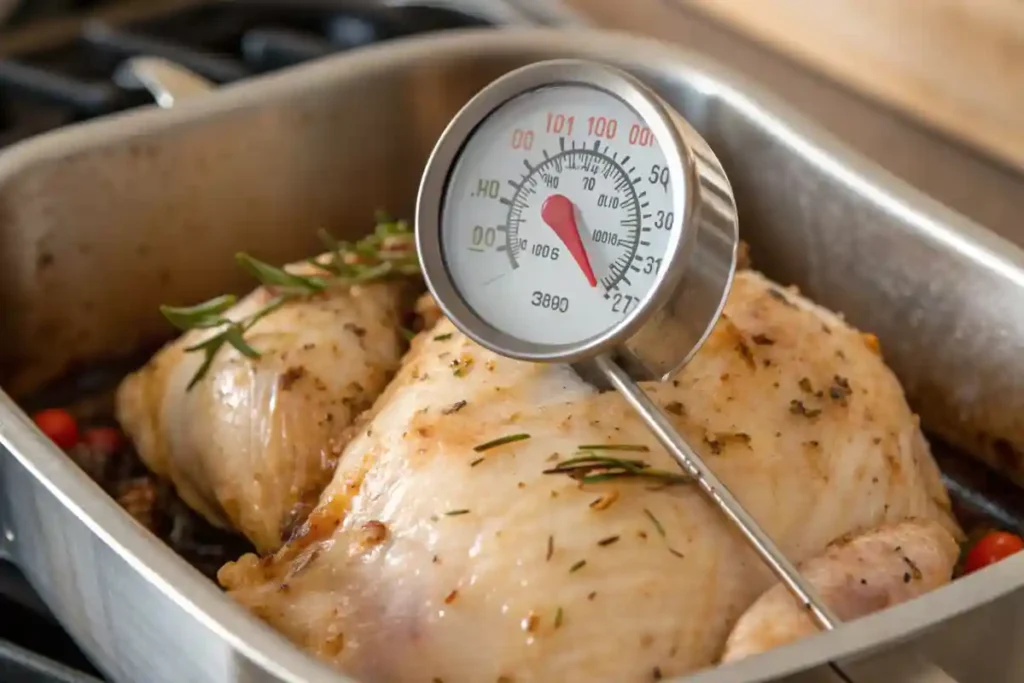
Cooking one-pan chicken and potatoes to their respective safe internal temperatures is a crucial step in preventing foodborne illnesses. Properly cooked chicken eliminates harmful bacteria, while thoroughly cooked potatoes ensure a satisfying texture and flavor. This section provides detailed guidance on achieving these temperatures and testing for doneness.
Importance of Cooking Chicken and Potatoes to Safe Temperatures
Cooking chicken and potatoes together requires careful attention to temperature to ensure both are safe to eat. Chicken must reach an internal temperature of 165°F (74°C) to eliminate bacteria like Salmonella. Potatoes should be cooked until they are tender and easily pierced with a fork. Cooking them together in one dish is convenient, but it’s essential to confirm that both ingredients are fully cooked before serving.
Using a meat thermometer is the most reliable way to verify the chicken’s doneness. Insert the thermometer into the thickest part of the chicken without touching bone, as this can skew the reading. For potatoes, visual cues such as a golden-brown crust or fork-tender consistency are good indicators.
Ensuring both ingredients are cooked thoroughly not only guarantees safety but also enhances the meal’s overall taste and texture.
Recommended Internal Temperatures for Chicken
Chicken is considered safe to eat when its internal temperature reaches 165°F (74°C). This temperature effectively kills bacteria like Salmonella and Campylobacter. Thicker cuts, such as chicken breasts or thighs, may take longer to reach this temperature, so always check multiple pieces if cooking several portions at once.
For dishes like roasted chicken and potatoes, it’s helpful to cook the chicken on a higher rack or on top of the potatoes. This positioning allows heat to circulate effectively, ensuring even cooking. Additionally, always allow the chicken to rest for 5–10 minutes after cooking to let the juices redistribute, making it more flavorful and moist.
Ensuring Potatoes Are Thoroughly Cooked
Potatoes should be cooked until they are tender and easy to pierce with a fork. Undercooked potatoes can be unpleasant to eat, and when cooked alongside chicken, they may absorb juices that need thorough heating to ensure safety.
For roasting, aim for an oven temperature of 375°F–400°F (190°C–200°C). At this heat, both chicken and potatoes typically cook evenly. Stirring the potatoes midway through cooking can help them brown evenly while ensuring they reach the right consistency. If you’re boiling potatoes, they’re ready when a fork slides in without resistance.
Common Mistakes to Avoid
Cooking one-pan chicken and potatoes together can seem straightforward, but several common mistakes can affect both safety and flavor. These pitfalls include undercooking chicken, which poses health risks, and overcooking or undercooking potatoes, which impacts texture and taste. Let’s explore how to avoid these issues and ensure a successful meal.
Common Mistakes When Cooking Raw Chicken and Potatoes Together
One common mistake is not considering the different cooking times for chicken and potatoes. Chicken typically cooks faster than denser root vegetables like potatoes, especially if the chicken is cut into smaller pieces. Failure to monitor cooking progress can result in undercooked chicken or overly soft potatoes.
Additionally, not using a thermometer to check the chicken’s internal temperature can lead to health risks. Visual cues alone, like color or juices running clear, aren’t always reliable indicators of doneness. Finally, poor preparation practices, such as failing to separate raw ingredients during prep, can result in cross-contamination, which increases the risk of foodborne illnesses.
Undercooking Chicken
Undercooking raw chicken is one of the most serious mistakes. Chicken that hasn’t reached an internal temperature of 165°F (74°C) may harbor harmful bacteria like Salmonella or Campylobacter. Relying on appearance alone can be deceptive, as chicken can appear done on the outside but remain undercooked inside, especially in thicker cuts.
To avoid this, always use a reliable meat thermometer. Insert it into the thickest part of the chicken without touching bone for an accurate reading. If cooking in a dish with potatoes, ensure the chicken is positioned for even heat distribution, such as on top of the potatoes in a roasting pan.
Overcooking or Undercooking Potatoes
Potatoes can be tricky to cook alongside chicken because they require more time to become tender. Undercooking leaves them hard and unappetizing, while overcooking can make them mushy or burnt.
To achieve perfectly cooked potatoes, cut them into uniform pieces to ensure even cooking. Stirring them midway through roasting or adjusting the heat when boiling can also help. Checking their doneness with a fork ensures they are cooked to perfection. When roasting, placing potatoes under the chicken allows them to absorb flavorful drippings while cooking evenly.
Frequently Asked Questions
This section addresses common queries about cooking one-pan chicken and potatoes together. If you’ve ever wondered about the safety of this practice, the risks involved, or how to avoid contamination, the answers below will guide you.
Is it safe to cook raw chicken and potatoes together?
Yes, it is safe to cook raw chicken and potatoes together as long as both ingredients are properly handled and cooked thoroughly. Chicken must reach an internal temperature of 165°F (74°C) to kill harmful bacteria, while potatoes should be tender and fully cooked. Ensure that raw chicken juices don’t come into contact with ready-to-eat foods during preparation.
What are the risks of cooking chicken and potatoes together?
The primary risks involve cross-contamination and undercooking. Raw chicken can carry bacteria like Salmonella, which can spread to potatoes or other ingredients during prep if not handled carefully. Undercooking chicken or potatoes can result in unsafe food or poor texture. Proper hygiene, preparation, and cooking techniques minimize these risks.
How can I prevent cross-contamination?
To prevent cross-contamination, keep raw chicken and potatoes separate during prep. Use different cutting boards, knives, and utensils for each ingredient, and wash your hands thoroughly after handling chicken. Disinfect surfaces and utensils immediately after use. Cooking both ingredients together in a single dish is safe as long as they are heated to appropriate internal temperatures.
Conclusion
one-pan chicken and potatoes together can be both safe and delicious when you follow the proper precautions. By understanding the risks of cross-contamination and the importance of cooking to appropriate internal temperatures, you can confidently prepare a flavorful, one-pan meal without compromising safety.
Is it OK to cook raw chicken and potatoes together ,Throughout this guide, we’ve explored best practices for food safety, including handling raw chicken with care, properly washing and preparing potatoes, and ensuring thorough cooking. We’ve also highlighted common mistakes to avoid, such as undercooking chicken or overcooking potatoes. Using tools like a meat thermometer and maintaining a clean kitchen are essential steps to prevent any issues.
When these guidelines are followed, combining chicken and potatoes creates a satisfying, time-saving dish that’s both nutritious and flavorful. Armed with these tips, you’re ready to create meals that are not only enjoyable but also completely safe to share with family and friends.
